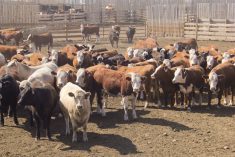Chicago | Reuters — Chicago Board of Trade (CBOT) soybean futures on Monday rallied for a second consecutive session, following a shockingly low plantings estimate from the U.S. Department of Agriculture (USDA) on Friday.
Corn futures eased at the start of this holiday-shortened week, remaining at a 2-1/2 year low, on choppy technical trading, traders said.
Corn prices rose earlier in the session on bargain buying and signs of growing demand. Several import tenders were issued on Monday by buyers in South Korea and a large private purchase reported over the weekend.
Read Also

U.S. livestock: Feeder cattle hit contract highs on tight supply
Chicago | Reuters – All Chicago Mercantile Exchange feeder cattle futures and most live cattle futures hit contract highs on…
But corn futures could not shake off pressure from larger-than-expected U.S. corn plantings and smaller-than-expected June 1 corn stocks released on Friday by USDA, traders said.
U.S. markets, including the CBOT, will be closed on Tuesday for the Independence Day holiday.
Chicago Board of Trade most-active soybeans settled up 10-1/2 cents at $13.53-3/4 a bushel (all figures US$). Prices hit the highest intraday level since June 15 at $13.91-3/4 a bushel.
CBOT soybean, soymeal and soyoil futures traded within their expanded limits on Monday, after CBOT soyoil futures closed up their normal daily limit on Friday.
Corn settled down 1-1/4 cent at $4.93-1/2 a bushel. Wheat followed corn, falling 9-1/4 cents to settle at $6.41-3/4 a bushel.
The department cut its estimate of U.S. 2023 soybean plantings to 83.5 million acres, down four million acres from its March 31 forecast and below a range of trade estimates.
“If USDA’s estimate is accurate, the margin of error for U.S. soybean yields shrinks significantly and places even more importance on a shift in the weather pattern for the Midwest in the near future,” StoneX chief commodities economist Arlan Suderman wrote in a client note.
— Reporting for Reuters by P.J. Huffstutter in Chicago; additional reporting by Michael Hogan in Hamburg and Naveen Thukral in Singapore.
















